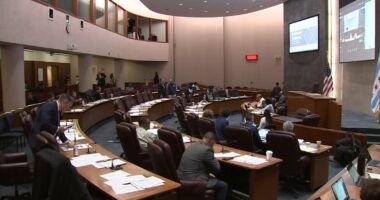Share this @internewscast.com
On Tuesday, a federal court invalidated the newly proposed Republican congressional map in Texas. This map was designed to potentially flip up to five seats currently held by Democrats. The court determined that the redistricting plan constituted illegal racial gerrymandering, which aimed to suppress the voting power of Black and Latino communities.
In a decision that caught many by surprise, a three-judge panel voted 2-1 against the new map. They ruled that Texas must revert to its previous district map for the upcoming 2026 midterm elections. This previous map had been altered at the behest of former President Trump to bolster Republican control in the House of Representatives.
The court’s judgment followed a thorough two-week hearing. It pointed fingers at Texas lawmakers, accusing them of redrawing district boundaries to weaken the influence of minority voters, thereby obstructing their ability to elect preferred candidates.
“This goes beyond mere politics,” stated Justice Jeffrey Brown, who serves as a district court judge in Galveston, Texas. Appointed by Trump, Brown emphasized in the ruling that substantial evidence pointed to racial gerrymandering in the 2025 map.
The decision saw dissent from an appellate judge appointed by Ronald Reagan, while a district judge appointed by Barack Obama sided with Justice Brown.
Any appeal against this ruling must be directed to the U.S. Supreme Court. The Supreme Court justices would need to act swiftly if they intend to reverse this decision, as Texas election laws require candidates to declare their candidacies by early December.

If it stands, the ruling would amount to a massive political blow to Trump and his Republican allies.
Trump started an unprecedented mid-decade redistricting war last summer when he ordered GOP lawmakers in Texas to redraw its map to expand its already healthy 25-13 margin to as much as 30-8.
The new map, enacted over the bitter objections of Democrats, scrapped three blue districts in the Dallas, Houston and Austin areas by packing Democratic voters into fewer districts. It also added Republican areas to two Democratic-held districts in the Rio Grande Valley in hopes of making it much more difficult for the Democratic incumbents to win reelection.

The Texas move triggered similar actions by Republicans in other red states, including moves that are likely flip one Democratic-held seat each in Missouri, North Carolina and Ohio.
Democrats struck back, most notably in California, where voters overwhelmingly passed a measure aimed at redrawing the deep blue Golden State’s districts to pick up five seats of their own.
Virginia may also redraw its map to scrap three or four Republican seats after Democrats won a crushing victory in this month’s off-year elections.
New York Democrats have also discussed rejiggering the Empire State’s congressional map to expand their 19-7 edge, but no changes could be enacted in time for the 2026 midterms.
It wasn’t immediately unclear how or if the Texas ruling may impact the politics surrounding other redistricting efforts or legal challenges to them.
In general, courts have ruled that racial gerrymandering is impermissible while the Supreme Court ruled that redistricting for purely partisan political reasons is not illegal. The justices are considering a separate case that could upend a key portion of the Voting Rights Act and would potentially allow Republicans to scrap many Black and Latino-held districts in red states.
Republicans hold only a narrow five-seat majority in the House, meaning Democrats could retake control if they flip just a handful of seats. That would potentially give them the power to frustrate Trump’s aggressive right-wing policy push in his second term.

















